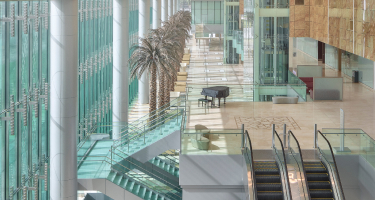Our Doctors
Meet all the doctors from Cleveland Clinic Abu Dhabi.
View Doctors

A stroke can be a life-threatening condition. It happens when the blood supply to the brain is suddenly interrupted, either by an artery blockage or a burst blood vessel. Urgent medical attention is essential.
Strokes are the leading cause of disability in the UAE, and the third leading cause of death. But immediate emergency medical treatment can limit the damage caused by a stroke and ultimately save a person’s life.
By recognizing the signs of a stroke, and ensuring treatment is received as quickly as possible, you can reduce the likelihood of permanent damage and save a life. If you think someone is having a stroke, you need to BE FAST.
The main warning signs of a stroke can be easily remembered by the words B.E. F.A.S.T:
There are two main ways in which a stroke happens:
Ischemic stroke: This is the most common type of stroke, where something blocks the blood vessels in the brain, preventing blood flow. Ischemic stroke can happen in different ways:
Hemorrhagic stroke: The most serious type of stroke, where a blood vessel in the brain bursts and causes a bleed on the brain.
Called a transient ischemic attack (TIA), a mini stroke happens when the blood supply to the brain is temporarily interrupted, anywhere from a few minutes to 24 hours. A TIA won’t cause permanent damage to the brain, however, it should always be treated immediately and considered as a warning sign of a possible full stroke in the future.
Ischemic strokes are usually caused by blood clots, which can happen as a result of:
Hemorrhagic stroke can be caused by a number of things, including:
There are a number of other conditions that can increase the risk of stroke, including:
In the UAE, the average age of a stroke patient is 45. This is up to 20 years younger than the global average. The early onset is believed to be caused by the high prevalence of modifiable risk factors (things we can change) in UAE adults, such as obesity, smoking, and diabetes. It is estimated that 25% of all adults in the UAE are living with high blood pressure, one of the major risk factors for stroke, putting our population at high risk.
If your doctor suspects a stroke, they will perform a number of diagnostic tests, which may include:
The treatment and medication given to someone who has had a stroke will depend on many different factors. If someone has had an ischemic stroke, treatment aims to restore blood circulation to the affected areas of the brain as quickly as possible. In people who have had a hemorrhagic stroke, the aim is to reduce blood pressure to reduce the amount of bleeding.
Treatments may include:
Recovery from a stroke is different for every patient. Many people recover completely, while others are left with physical limitations, such as difficulty walking, speech problems, and the ability to perform daily activities. Rehabilitation after a stroke can help overcome these limitations. Physical, occupational, and speech therapists are trained to help stroke patients get back as much independence as possible. By building strength, mobility and confidence, they help patients to live their lives to the fullest.
Read more about life after a stroke here.
© Copyright 2025 Cleveland Clinic Abu Dhabi. All rights reserved.
This page has been reviewed by a medical professional from Cleveland Clinic Abu Dhabi. Information on this page is not intended to replace the medical advice of your doctor or health care provider. Please consult your health care provider for advice about a specific medical condition.
Learn more about our editorial process here.
We’re here to make managing your healthcare easier.